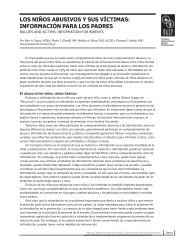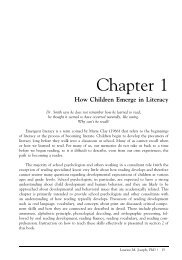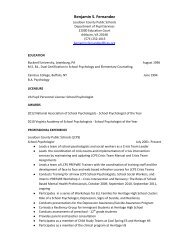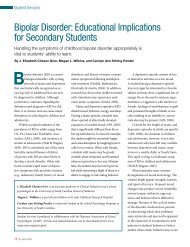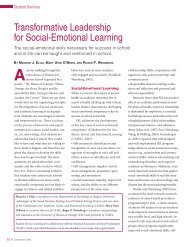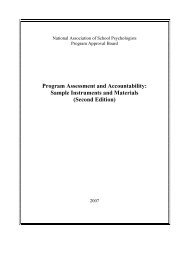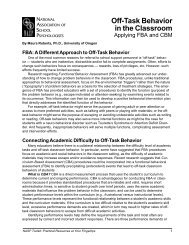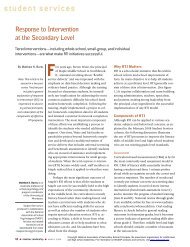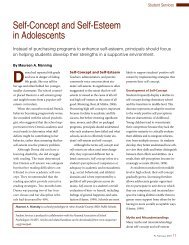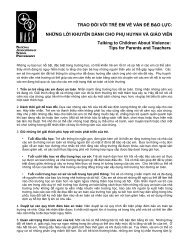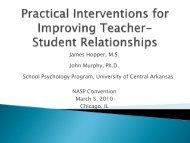Best Practices in Play Assessment and Intervention
Best Practices in Play Assessment and Intervention
Best Practices in Play Assessment and Intervention
You also want an ePaper? Increase the reach of your titles
YUMPU automatically turns print PDFs into web optimized ePapers that Google loves.
<strong>Best</strong> <strong>Practices</strong> <strong>in</strong> School Psychology V<br />
serve eligibility purposes but do not provide <strong>in</strong>formation<br />
about how to develop or monitor appropriate <strong>in</strong>terventions,<br />
they are not ecologically valid <strong>and</strong> do not assess<br />
the child <strong>in</strong> the natural context, <strong>and</strong> they are a<br />
potentially unmotivat<strong>in</strong>g <strong>and</strong> <strong>in</strong>appropriate means of<br />
gather<strong>in</strong>g valid <strong>in</strong>formation about a young child (Kelly-<br />
Vance & Ryalls, 2005). Further, many practitioners<br />
have expressed misgiv<strong>in</strong>gs about the use of tests to<br />
determ<strong>in</strong>e young children’s current level of performance<br />
(Barnett, Macmann, & Carey, 1992) <strong>and</strong> would prefer to<br />
use alternative strategies such as play assessment<br />
(Bagnato & Neisworth, 1994).<br />
The orig<strong>in</strong>s of play assessment <strong>and</strong> <strong>in</strong>tervention<br />
stem from psychoanalytic work with children at the<br />
turn of the twentieth century. Therapists used <strong>in</strong>formation<br />
from children’s play to determ<strong>in</strong>e their mental<br />
health needs <strong>and</strong> then used the play context dur<strong>in</strong>g<br />
therapy. This practice cont<strong>in</strong>ues <strong>in</strong> many different<br />
therapeutic approaches. More recently <strong>and</strong> for the<br />
reasons discussed above, school psychologists work<strong>in</strong>g <strong>in</strong><br />
early childhood began us<strong>in</strong>g play assessment as an<br />
observational strategy <strong>in</strong> the 1980s (as discussed <strong>in</strong><br />
Athanasiou, 2007). L<strong>in</strong>der (1990) brought even more<br />
attention to the procedures with the publication of<br />
her play assessment model <strong>and</strong> her subsequent play<br />
<strong>in</strong>tervention model (L<strong>in</strong>der, 1993a, 1993b). Practitioners<br />
have been us<strong>in</strong>g play assessment <strong>and</strong> <strong>in</strong>tervention, but<br />
the empirical support for its use has only recently<br />
emerged (e.g., Cherney, Kelly-Vance, Gill-Glover,<br />
Ruane, & Ryalls, 2003; Farmer-Dougan & Kaszuba,<br />
1999; Kelly-Vance, Needelman, Troia, & Ryalls, 1999;<br />
Kelly-Vance & Ryalls, 2005; Kelly-Vance, Ryalls, &<br />
Gill-Glover, 2002; Myers, McBride, & Peterson, 1996).<br />
Fortunately, studies are confirm<strong>in</strong>g what practitioners<br />
have known <strong>in</strong>tuitively, which is that this approach is a<br />
reliable <strong>and</strong> valid means of assess<strong>in</strong>g young children (see<br />
below). Moreover, the assessment procedures can be<br />
used regularly to monitor the progress of children<br />
receiv<strong>in</strong>g <strong>in</strong>terventions.<br />
Tra<strong>in</strong><strong>in</strong>g <strong>and</strong> Equipment<br />
While the specific materials <strong>and</strong> procedures required for<br />
different versions of play assessment <strong>and</strong> <strong>in</strong>tervention<br />
vary, all forms are similar enough that general guidel<strong>in</strong>es<br />
concern<strong>in</strong>g equipment <strong>and</strong> tra<strong>in</strong><strong>in</strong>g can be provided.<br />
With regard to equipment, one of the advantages of play<br />
assessment <strong>and</strong> <strong>in</strong>tervention is that no specialized<br />
materials, forms, or equipment are required. All types<br />
of play assessment <strong>and</strong> <strong>in</strong>tervention <strong>in</strong>volve children<br />
play<strong>in</strong>g with toys or other play materials (e.g., crayons<br />
<strong>and</strong> paper). While some forms of play assessment do<br />
require a particular set of play objects (e.g., Fewell as<br />
cited <strong>in</strong> Athanasiou, 2007), others can be conducted <strong>in</strong><br />
any toy room or early childhood classroom (e.g., Kelly-<br />
Vance & Ryalls, 2005; L<strong>in</strong>der, 1993a; Ryalls et al.,<br />
2000) as long as the available toys are diverse enough to<br />
elicit a wide range of play behaviors, <strong>in</strong>clud<strong>in</strong>g complex<br />
pretend play, <strong>and</strong> are attractive to both boys <strong>and</strong> girls.<br />
Some specific considerations regard<strong>in</strong>g toy choice will<br />
be discussed below.<br />
Although no specialized equipment is necessary to<br />
conduct play assessments or <strong>in</strong>terventions, some tra<strong>in</strong><strong>in</strong>g<br />
<strong>and</strong> experience is necessary; however, the nature of this<br />
tra<strong>in</strong><strong>in</strong>g depends on the RTI tier <strong>in</strong> question. Certa<strong>in</strong>ly,<br />
knowledge about child development <strong>in</strong> general, <strong>and</strong> the<br />
developmental course of play <strong>in</strong> particular, is necessary<br />
at all three RTI tier levels. A thorough underst<strong>and</strong><strong>in</strong>g of<br />
a tiered RTI system <strong>and</strong> the specific problem-solv<strong>in</strong>g<br />
approach used with children who have more <strong>in</strong>tense<br />
needs is necessary <strong>in</strong> utiliz<strong>in</strong>g play assessment to guide<br />
the <strong>in</strong>tervention process. With regard to the <strong>in</strong>formal<br />
assessments that occur at Tier 1, the school psychologist<br />
needs to make sure the personnel <strong>and</strong> parents <strong>in</strong>volved<br />
have a general underst<strong>and</strong><strong>in</strong>g of how <strong>and</strong> when play<br />
changes with development. At Tier 2 or 3, most forms of<br />
play assessment can be considered observational cod<strong>in</strong>g<br />
systems, <strong>and</strong> thus some experience us<strong>in</strong>g such systems is<br />
beneficial. Familiarity with the specific cod<strong>in</strong>g system is<br />
obviously required, as is some tra<strong>in</strong><strong>in</strong>g <strong>and</strong> experience<br />
identify<strong>in</strong>g particular examples of success or failure or<br />
assign<strong>in</strong>g specific codes to play behaviors (e.g., substitution).<br />
As with any observational cod<strong>in</strong>g system, such<br />
experience is necessary to ensure the reliability of the<br />
assessment across observers <strong>and</strong> across play sessions<br />
(Salvia, Ysseldyke, & Bolt, 2007). The nature <strong>and</strong><br />
amount of tra<strong>in</strong><strong>in</strong>g depends on the particular form of<br />
play assessment <strong>in</strong>volved. With respect to the type of<br />
tra<strong>in</strong><strong>in</strong>g required for actual <strong>in</strong>tervention implementation,<br />
all <strong>in</strong>terventions are grounded <strong>in</strong> the context of<br />
play <strong>and</strong> thus require no specialized education or<br />
tra<strong>in</strong><strong>in</strong>g above <strong>and</strong> beyond the specific <strong>in</strong>terventions<br />
themselves.<br />
BEST PRACTICES<br />
Types of <strong>Play</strong> <strong>Assessment</strong><br />
Unlike other forms of early childhood assessment,<br />
relatively little activity has occurred <strong>in</strong> the development<br />
of play assessment techniques. Of those that exist, only<br />
three have been described <strong>in</strong> enough detail to use <strong>in</strong><br />
550 Chapter 33, Volume 2



